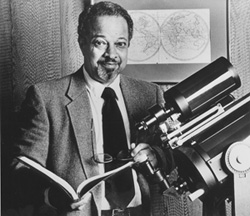
Arthur Bertram Cuthbert Walker, Jr. (August 24, 1936 – April 29, 2001) was a solar physicist and a pioneer of EUV/XUV optics. He is most noted for having developed normal incidence multilayer XUV telescopes to photograph the solar corona. Two of his sounding rocket payloads, the Stanford/MSFC Rocket Spectroheliograph Experiment and theMulti-Spectral Solar Telescope Array, recorded the first full-disk, high-resolution images of the Sun in XUV with conventional geometries of normal incidence optics; this technology is now used in solar telescopes such as SOHO/EIT and TRACE, and in the fabrication of microchips via ultraviolet photolithography.
Walker was born in Cleveland, Ohio on August 24, 1936, to Arthur and Hilda Walker. He was an only child.
Walker began his scientific career in the U.S. Air Force, and also worked at the Space Physics Laboratory of the Aerospace Corporation. He was a professor at Stanford University from 1974 until his death in 2001. His first graduate student, Sally Ride, went on to become the first American woman in space. He was instrumental in building Congressional approval for the National Solar Observatory, and served on the Rogers Commission which investigated the explosion of the Challenger Space Shuttle. Throughout his academic career, Walker championed minority and underprivileged students within the university system, and was a leader in the community of black physicists.
Walker died on April 29, 2001 at home on the Stanford campus, after battling cancer.
Walter S. McAfee (September 2, 1914 – February 18, 1995) was an African-American scientist and astronomer, notable for participating in the world’s first first lunar radar echo experiments with Project Diana.
In 1912 Susie Johnson took the examination for Texas teacher’s certification. She passed every part, but her spelling paper was mysteriously lost. Her father was told that if he paid $50 (2 months salary then), the paper could be found. Outraged, he refused to pay and Susie could not be a teacher. She married McAfee, a carpenter-farmer and had nine children. “She taught us,” said her son Walter McAfee. Six of her children obtained math or math related degrees, while the two others got degrees in chemistry.
Walter McAfee, born on Sept.. 2, 1914, in Ore City, Texas, attended public schools in Marshall, Texas, graduating high school with honors. He enrolled in Wiley College (Texas) where, in 1934, he graduated magna cum laude with a bachelor’s degree in Mathematics. In 1937 he earned a Master of Science in Physics from Ohio State University. McAfee earned a Ph.D. in physics from Cornell University in 1949.
During World War II, Walter McAfee was a member of the U.S. Army Signal Corp Engineering Laboratories. There he distinguished himself in electromagnetism and radar. He was a member of the Project Diana team that was responsible for the first lunar radar echo experiments in 1946. The goal of Project Diana was to determine if a high frequency radio signal, could penetrate the outer atmosphere of the earth. The solution was to send a radar signal to the moon and bounce it back to earth. For this they needed an accurate computation of the velocity of a position on the moon relative to a position on the earth. Dr. McAfee performed the calculations, and on Jan. 10, 1946, the experiment was successfully conducted. Unfortunately, McAfee’s contributions to Project Diana (even his name) were not mentioned in news reports about the experiment.
Dr. Walter McAfee was a scientific advisor to the U.S. Arm Electronics Research and Development Command. For 42 years he worked for the government at New Jersey”s Fort Monmouth including service as director of a NATO study on surveillance and target acquisition. He was also a scientific advisor to the U.S. Arm Electronics Research and Development Command. He concurrently lectured in atomic and nuclear physic and solid state electronics at Monmouth College from 1958 to 1975.
Dr. McAfee was awarded an honorary doctorate in science from Monmouth University in 1958, and the Steven’s Award from Steven’s Institute of Technology in 1985. Dr. McAfee received the Rosenwald Fellowship in Nuclear Physics and the Secretary of the Army Fellowship, presented by President Eisenhower at a White House ceremony. The fellowship enabled McAfee to study radio astronomy for two years at Harvard University. Dr. McAfee is listed in “American Men and Women of Science,” “Who’s Who in the East,” and “Who’s Who Black Americans. “
McAffee died at his home in South Belmar, New Jersey, on February 18, 1995.
***Information courtesy of Wikipedia.org and Astronomers of the African Diaspora***


